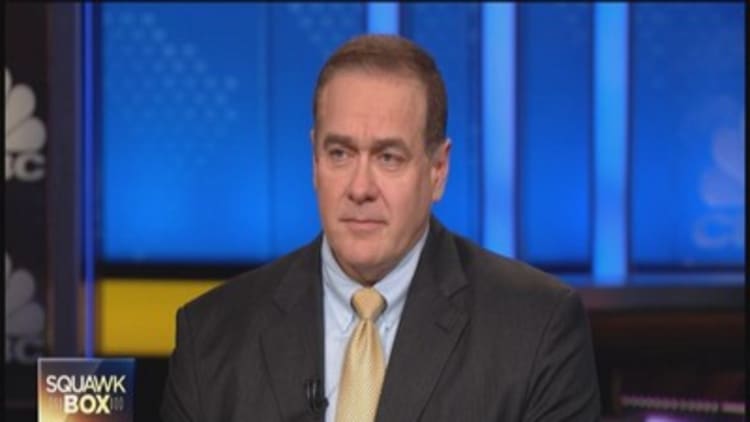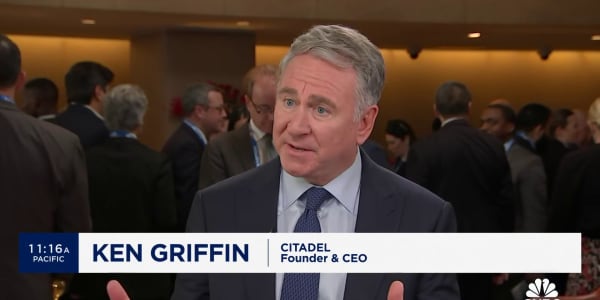Guggenheim Partners has slashed personnel at an internal hedge fund that hasn't lived up to big expectations.
The $220 billion asset management and investment banking firm cut at least eight senior employees in December at Guggenheim Global Trading, a roughly $600 million hedge fund unit based in the New York suburb of Purchase.
The layoffs come amid mediocre performance and little success attracting external clients at GGT, which is led by RBC and Guggenheim fund of hedge funds veterans Loren Katzovitz and Patrick Hughes. There have even been discussions about Guggenheim shedding the unit by selling its majority stake to GGT's senior executives, according to one account.
A spokesman for Guggenheim declined to comment.
Big plans
It wasn't supposed to turn out this way.
GGT launched in 2011 with hopes to raise $2 billion and hire up to 25 teams with 150 total traders spread out between Purchase, Chicago, San Francisco, Geneva and Asia, according to Guggenheim statements at the time. Guggenheim then plowed more than $50 million into business operations, including iPad-based applications for risk monitoring and client reporting, according to marketing materials obtained by CNBC.com.
"We believe there are attractive opportunities to invest capital supporting trading strategies with high probabilities of success, particularly as banks are required to divest or significantly reduce their proprietary trading activities and smaller hedge funds find it uneconomical to continue," Katzovitz said at the launch.
Performance didn't match expectations.
The main fund, GGT Multi-Strategy, gained 3.19 percent in 2012 (from February to December) and 7.13 percent in 2013, according to marketing materials, but fell about 5 percent in 2014 through November, according to two people familiar with performance. Benchmark returns for similar hedge funds were higher each year: up 8.66 percent in 2012, 10.62 percent in 2013 and 5.06 percent in 2014, per the Absolute Return Multi-Strategy Index.
About 66 employees were hired as of late 2014, but with only 18 portfolio managers as of September, according to marketing materials. Virtually everyone was based in Purchase, with an outpost in Zug, Switzerland.
That employee total has likely fallen. The layoffs include seven portfolio managers for GGT, who invested across a range of strategies, including corporate events, stock volatility and emerging markets. They were: Steven Eick, Paul Horowitz, Michael Cohen, Gregor Dannacher, Francisco Drohojowski, Jamie Waters and Vinay Datta, according to people familiar with the situation.
The reasons for those cuts were unclear; performance varied for each team given different strategies. Most of the portfolio managers who were let go were surprised to hear the news, according to people familiar with the situation.
The fund's top marketer, Marjorie Kaufman, was also let go in December. She was hired in March 2014 after raising about $5 billion from clients as the head of marketing and investor relations at hedge fund firm Kingdon Capital from 2003 to 2010, according to her LinkedIn profile.
All those who left either declined to comment or did not respond to requests.
Read MoreThe best hedge funds for 2015 are...

"Guggenheim cut some great people—it shows how brutal the competition in hedge funds has become," said Kate Quinn, a financial industry recruiter at DHR International.
Quinn added that tepid returns likely didn't help, even if the strategy was for relatively steady, tempered gains.
"Investors look at the equity index and have come to expect quick pops and returns. It's mission-critical to maintain a top track record," Quinn said.
GGT's assets also didn't increase much from its launch.
While GGT was set up to trade internal capital, it also sought institutional investors who could take small ownership stakes with minimum initial investments of $10 million or more, according to filings with the Securities and Exchange Commission. But GGT ended up with about $600 million in assets today, most of it internal capital from Guggenheim.
Unclear future
Parent Guggenheim said it viewed GGT "as a strategically important business," in a September 2014 prospectus. But Hedge Fund Alert reported in December that management was in discussions to buy out Guggenheim's stake. That account could not be independently verified.
Read MoreAckman, Robbins, Loeb score as hedge fund pay lags
GGT isn't the only Guggenheim hedge fund unit to lose personnel.
Mike Damaso, who had been chairman of the investment committee overseeing corporate credit investing and a portfolio manager for the NZC Guggenheim Fund, left at year-end to be vice chairman of A24 Films, a New York-based movie company that Guggenheim had invested in.
Damaso declined to comment, but two people familiar with the situation said that the split was amicable and Damaso simply wanted a new challenge after 16 years in the financial services industry. Damaso had already been on the board since A24 launched three years ago and had worked at Guggenheim since 2001.






